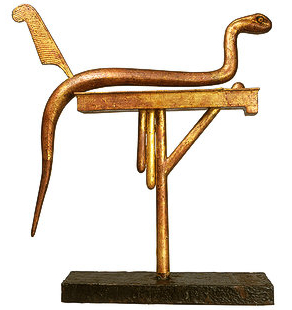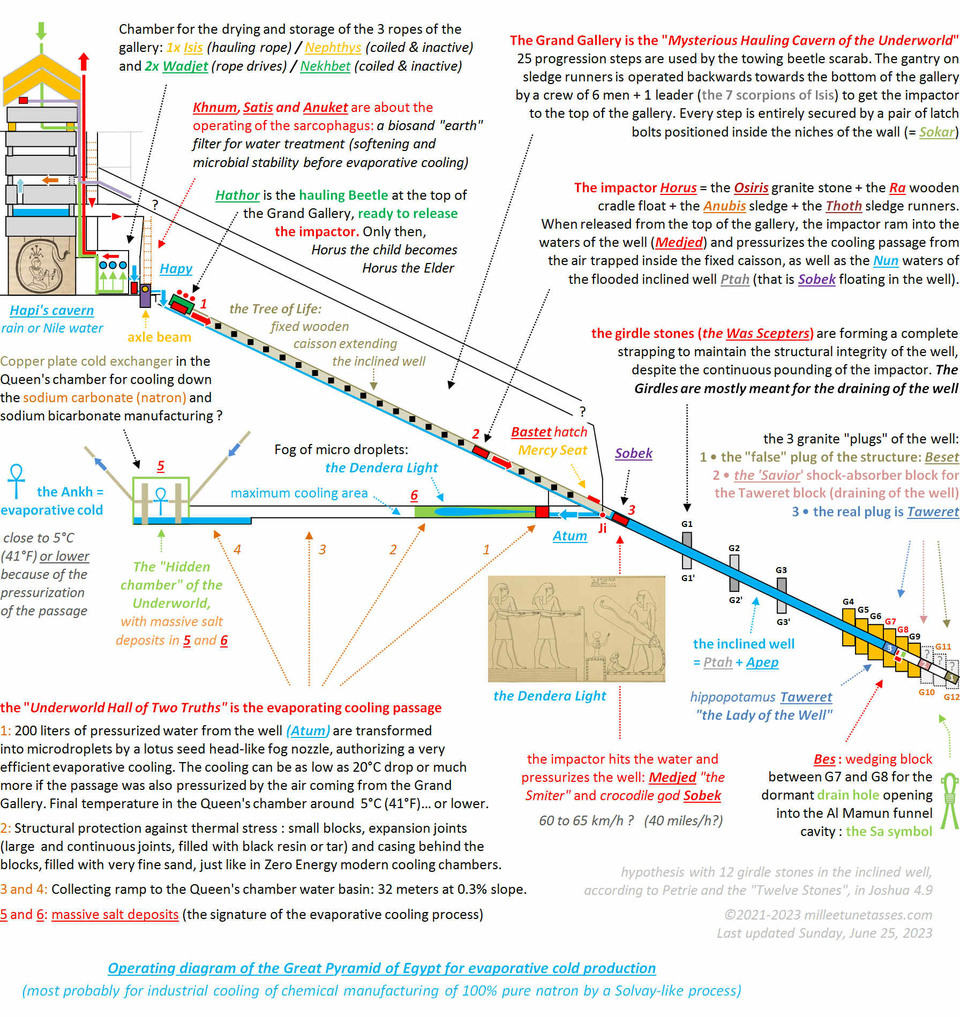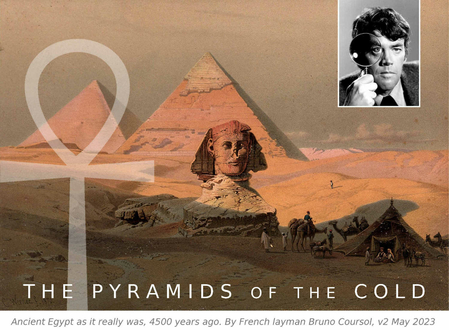- Retour accueil
- Vous êtes ici : Blog The Pyramids of the Cold v2 The Pyramids of the Cold Section 39 • The cooling water of spitting Kebechet
The Pyramids of the Cold Section 39 • The cooling water of spitting Kebechet
Publié par Bruno Coursol dans The Pyramids of the Cold v2 le 13/05/2023 à 18:43

Ancient Egypt: the pyramids at Giza and the Sphinx. Color lithograph by G.W. Seitz, ca. 1878, after Carl Werner, 1870: https://wellcomecollection.org/works/exnpzjwc/images?id=x3jjcet6
The Pyramids of the Cold v2 (May 2023) • Conclusion
Section 39 • The cooling water of spitting Kebechet

At this point, you might ask yourself why ancient Egyptians wouldn't have glorified the process of cooling by simply using the power of water I'm talking about; and the fact is that they did exactly just that: just like every other parts we've seen so far, cooling water itself had indeed been glorified into another deity.
Her name, because they've chosen a goddess to deified cooling water, is Kebechet; and even if it really looks like she had a very important role in the ancient Egyptian "religion", it also looks like egyptologists don't really seem to like her very much, and Kebechet is clearly seen as pretty much "the good hostess of the house", so to speak.
Of course, the reality is way different; if egyptologists are right when they use the terms "cooling water" about Kebechet, they're wrong with the use of this cooling water: they shouldn't talk about "refreshment", like in the Step Pyramid of Djoser "The Refreshment of the Gods", but really they should have stuck with the "cooling" word, because the cooling was really what they cared about.
Representation of the ancient Egyptian goddess Kebechet (Qebhet) in her spitting snake form.

39.01 The problem of the deification of the fog nozzle
If you've read every Section of the Pyramids of the Cold v2, you've probably noted one very important point: how did the ancient Egyptians have deified the fog nozzle of the evaporative cooling passage?
Because even if we see Horus holding the nozzle in some very famous figures of the god, and pointing it towards his face to cool down himself (of course, this is only a metaphor), there is not a single deity glorifying the nozzle itself.

39.02 The snake spitting his venom metaphor: is Kebechet the deification of the fog nozzle?
It is actually what we call the "Dendera light" that might give us the solution, because it does really look like it is a snake spitting his venom that is creating the Dendera light.
What it means, is that if ancient Egyptians did want to deify the fog nozzle, the spitting snake would have been the absolute perfect metaphor; and if you look at the very rare representations of Kebechet you can find on the internet, she really is represented into the characteristic spitting snake position.
So yes, I would say that Kebechet really is the fog nozzle!

The ancient Egyptians themselves did actually explained, their own way, that the Dendera light is "produced" by the sprayed venom of a spitting snake. That is what Kebechet is all about; she should be called "spitting" Kebechet.
Dendera Light relief drawing on the left : please notice that what seems to be important here isn't the snake, but the spat venom of the snake. Also, you can see that the characters holding the snake are showing a double outline, the same way that the character holding (or offering) the Dendera Light does, on the right part of the drawing. The Dendera Light is produced by the snake, or as explained : by the venom of the snake. This particular relief is describing how was produced the microdroplets fog of sprayed water. Dendera Light drawing from the New York Public Library (Digital Collections). Author : Auguste Mariette, 1821-1881
39.03 The venom spray of a spitting snake: that is what Kebechet is really all about
The ascending passage of the Great Pyramid of Giza was actually flooded and the fall of an impactor (wooden cradle float + granite block), pressurized the ascending passage (the inclined well) and so generated high-pressurized water that was sprayed inside the horizontal passage into a microdroplets fog, that instantly vaporized itself and by doing so, cooled down the air temperature. This is an adiabatic cooling process, that can cool down the air very effectively, with a 15 to 20°C drop.
That fog of liquid water microdroplets, is the Dendera Light.
That drawing of one of the Dendera Light reliefs, is absolutely outstanding, because it is organized the same way we do today in every single science book : the theoretical part on one side and the practical part on the other side.
On the left side of the drawing, we can see that the key element is the spat venom of the snake and not the snake by itself : that represents the sprayed water ; and on the right side we can see the practical application of the concept inside the horizontal passage of the Great Pyramid : from the inclined well (the ascending passage), is the water pipe going to the fog nozzle and resulting in the microdroplets fog.
Please note that 1/ the angle of the Dendera Light Bulb is very similar to the angle of the typical venom spray of a spitting snake ; and 2/ the shape of the Light Bulb is very similar to the shape of the horizontal passage.

The real ancient Egyptian gods and goddesses family tree.
39.04 The schematic diagram of the cooling of the ancient Egyptian gods
Last updated May 12, 2023 with the comprehension of Kebechet as the deification of the fog nozzle itself, at 14h41.
If you read the Wikipedia's page on Kebechet, you'll have merely a couple of lines about her (I'm just overstating a little bit here), so every excerpt in this Section comes from the World History Encyclopedia: https://www.worldhistory.org/Qebhet/

"Qebhet (also known as Kebehwet, Kabechet or Kebechet) is a benevolent goddess of ancient Egypt. She is the daughter of the god Anubis, granddaughter of the goddess Nephthys and god Osiris, and is the personification of cool, refreshing water as she brings drink to the souls of the dead in the afterlife Hall of Truth."
"Qebhet never had her own cult or area of specialization beyond a comforter of the souls of the dead. She is mentioned frequently in the Egyptian Book of the Dead as she brings water to the souls as they stand awaiting judgment by Osiris and the Forty-Two Judges in the afterlife. Her name is frequently translated as "cooling water" and she was associated with the life-giving waters of the Nile River."
"Like Nephthys, she was regarded as a friend of the dead who uplifted the hearts of those who had passed on from life to eternity but had not yet been justified by Osiris and allowed to move on to the paradise of the Field of Reeds. She is associated with the goddess Ma'at, personification of harmony and balance, in that she offers comfort to those in need and stabilizes the soul prior to its appointed judgment."
"She was originally a serpent deity, known as "the celestial serpent" in the Pyramid Texts (c. 2400-2300 BCE) but was re-imagined as a goddess associated with the land of the dead, daughter of Anubis and "the king's sister", though who the `king' is remains unclear."

"One of the most important aspects in honoring the dead in ancient Egypt (as well as Greece and elsewhere) was their remembrance and no one wished to think of their departed loved one thirsting while awaiting trial before the great god Osiris in the afterlife. Qebhet, therefore, played an important role in the rituals of death in that she assured the still-living that their loved one was cared for and, furthermore, that they themselves would also be when it came their own time to stand in the hall of judgement. Further, the ritual cleansing of the body of the corpse by clean water was a vital element in the burial of the dead and Qebhet symbolized this purification."
"She was also thought to play an especially vital role in the revival of the soul after death. Egyptologist Richard H. Wilkinson writes how Qebhet personally tended the soul of the dead king and "refreshed and purified the heart of the deceased monarch with pure water from four nemset jars [ritual funerary vessels] and that the goddess helped open the `windows of the sky' to assist the king's resurrection" (223). To `open the windows of the sky' meant to liberate the soul from the body and Qebhet seems to have come to perform this service for all the dead, not just the royalty. Her grandmother, Nephthys, was known as "Friend of the Dead" and Qebhet came to be associated with this same kind of care and concern for the departed souls."

"Qebhet is often pictured as a serpent or an ostrich bringing water. She was never worshipped to the degree of Isis or Hathor - or even much lesser deities - but was revered and respected and, at certain times, became associated with the Nile and cults which grew up in worship of the river. This is hardly surprising as she was always closely associated with pure, clean water."
"As the Nile was associated with Milky Way and the courses of the gods, Qebhet also became linked with the sky in both daylight and darkness. In her role as a purifier, she would also have been linked with the concept of ma'at, eternal harmony and truth, which was the central guiding principle in ancient Egyptian culture personified by the goddess of the same name."
All the above excerpts have been written by Joshua J. Mark for the World History Encyclopedia, and published on 17 February 2014.
I really hope Joshua and his institution will forgive me copying a big part of their text, and I really encourage you to go see the original post as there is a lot more content to read about Kebechet: I only copied what really linked the goddess with cooling water.

Diagram of the operating Great Pyramid of Egypt for evaporative cold production (hypothetically for chemical manufacturing cooling of pure sodium carbonate "natron", the salt used for the mummification of pharaohs). When in operation, the elevation of the Great Pyramid was not finished, and it is only after the shutdown procedure and the draining of the inclined well, that the 3 granite plugs were finally close to one another.

The Pyramids of the Cold version 2 (May 2023 - March 2024)
Summary of the study and Table of Contents
Part A: The evaporative cooling process
Section 1 • The horizontal evaporative cooling passage layout
Section 2 • The Dendera Light and the creation of the fog of microdroplets by the fog nozzle
Section 3 • The water cycle glorifying metaphors: Geb, Shu, Nut, Tefnut
Section 4 • The theorization of the evaporative cooling process by Akhenaten and Nefertiti
Section 5 • The theorization of the evaporative cooling process in the Weighing of the Heart
Part B • The inclined well of the Great Pyramid of Giza
Section 6 • The inclined well layout and the girdle stones
Section 7 • The Taweret "Lady of the Well" temporary sealing granite plug of the well
Section 8 • The Bes temporary wedging block immobilizing Taweret
Section 9 • The draining of the well
Section 10 • The Great Serpent Apep and the snake water metaphors
Section 11 • The Was scepter and the control over "snakes"
Section 12 • The beating Heart of the Great Pyramid
Part C • The composite impactor of the Great Pyramid (Horus, Ra, Osiris, Medjed, Sobek...)
Section 13 • The wooden and stone composite design of the impactor: Ra and Osiris
Section 14 • The endlessly immersed Osiris stone and the seed metaphor
Section 15 • The Anubis sledge and the bobsled mask
Section 16 • The sledge runners of the impactor: Thoth
Section 17 • Medjed: the smiter nobody can ever see
Section 18 • The Apis bull and the ramming impactor's metaphors
Section 19 • The crocodile god Sobek impactor (more or less) floating in the waters of the well
Section 20 • The Obelisk and the Benben stone rising from water
Part D • The Grand Gallery's of the Great Pyramid of Giza
Section 21 • The Sacred "sloping paths" of the "oval-shaped cavern of the act of Hauling"
Section 22 • The central wooden caisson of the Gallery: Sekhmet and the Triad of Memphis
Section 23 • The hauling ropes of the Grand Gallery: Isis, Nephthys, Hatmehit, Wadjet and Nekhbet
Section 24 • The hauling Beetle and the Seven Scorpions of Isis
Section 25 • The Great Cow goddess Hathor and the operating cycle of the hauling Beetle
Section 26 • The 10 operating phases of the Grand Gallery
Section 27 • The guide to the Afterlife for the smart traveler and the canopic jars
Section 28 • The scarab amulet glorifications of the hauling Beetle
Part E • The very large and roughly finished sarcophagus of the Great Pyramid
Section 29 • The biosand filter sarcophagus of the Great Pyramid
Section 30 • The Elephantine Triad deification of the biosand filter of the Great Pyramid
Section 31 • The Great Pyramid's operating flat roof and the water supply issue
Part F • Chemical manufacturing and industrial cooling before the Great Pyramid
Section 32 • The Serdab and the "Refreshment of the Gods" Step Pyramid of Djoser
Section 33 • Sneferu's Red Pyramid and the accumulated ammonia
Section 34 • The Disc of Sabu and the Solvay process for pure natron manufacturing
Part G • The tremendous impact of the Great Pyramid on the whole ancient world
Section 35 • The hidden secrets of the Hermetica Emerald Tablet (around 1600 C.E.)
Section 36 • Thor and the magical Hammer in the Great Hall of Bilskirnir
Section 37 • The Churning of the waters of the Ocean of Milk (Hindu mythology)
Section 38 • The Tibetan prayer wheels and the Grand Gallery's operation
Section 39 and Conclusion • The cooling water of spitting Kebechet
Part H • Epilogue
Section 40 • The smiting Ark of the Covenant and the Ten Commandments
Section 41 • The 293 kilograms windlass Staff of Moses and Aaron... and the First Plague of Egypt: water turning into blood
Section 42 • Ezekiel's Four Egyptian pulley "Wheels within the Wheels" and the four angel ropes
Section 43 • David, Saul, two giant Goliaths, five little stones, an aeolian harp... and a weaver's beam
Section 44 • The holy water fonts and the biosand filter
Part I • The magicians of the Great Pyramid of Giza
Section 45 • The Legend of Khufu and the "magician" polymath Imhotep
Section 46 • The two magical eyes of Isis and the brilliant but painful flame of her twin sister's braids
Poster un commentaire
